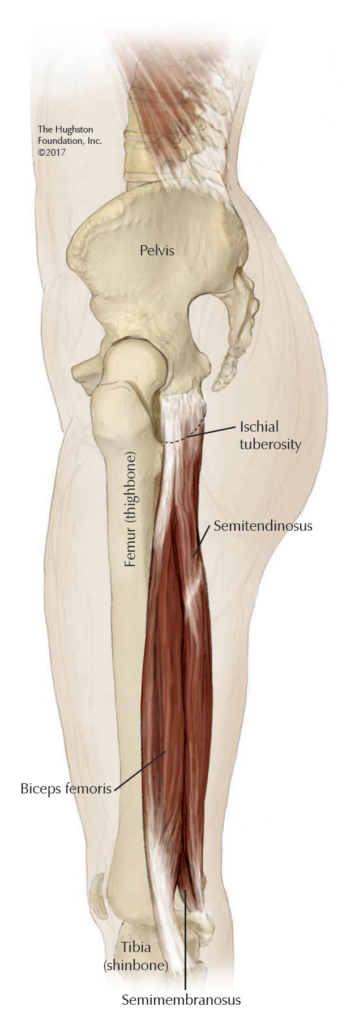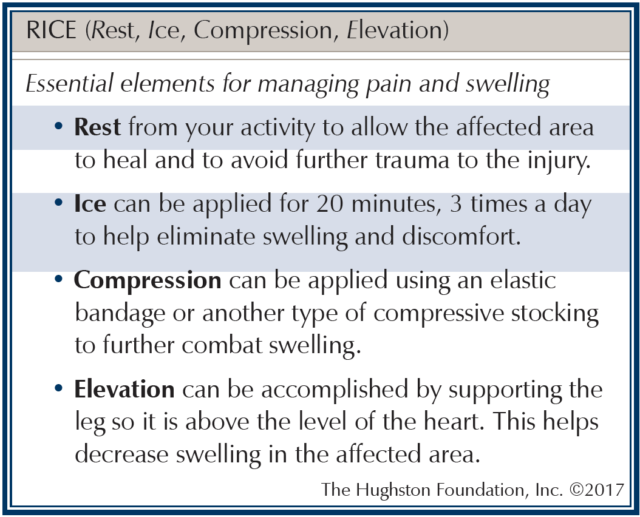
 Hamstring muscle strains (stretching or tearing a muscle or tendon) are common among athletes, accounting for about 29% of all sports related injuries. They often occur during sports that require running, jumping, kicking, pivoting, and rapid acceleration. Athletes of all sorts, but especially those who run are more likely to endure this painful injury. Others, including skaters and skiers, are known to strain their hamstring by falling while their hips are bent and their knees are straight. Hamstring injuries can be minor stretching or partial tearing of the muscle or tendon (attaches muscle to bone) that resolves with rest, rehabilitation, and medication; however, strains can also be much more serious, such as complete ruptures or avulsions (pulls bone away) that require surgical intervention.
Hamstring muscle strains (stretching or tearing a muscle or tendon) are common among athletes, accounting for about 29% of all sports related injuries. They often occur during sports that require running, jumping, kicking, pivoting, and rapid acceleration. Athletes of all sorts, but especially those who run are more likely to endure this painful injury. Others, including skaters and skiers, are known to strain their hamstring by falling while their hips are bent and their knees are straight. Hamstring injuries can be minor stretching or partial tearing of the muscle or tendon (attaches muscle to bone) that resolves with rest, rehabilitation, and medication; however, strains can also be much more serious, such as complete ruptures or avulsions (pulls bone away) that require surgical intervention.
Anatomy
The 3 hamstring muscles—the biceps femoris, the semitendinosus, and the semimembranosus—start at the ischial tuberosity at the bottom of the pelvis, and run along the back of the thigh, pass the knee joint, and stop at the tibia and fibula (lower leg bones) (Fig. 1). This group of muscles allows you to bend your leg at the knee and it helps with posture of the pelvis. All hamstring strains are painful to some degree, but the type of injury and where it is located determines the seriousness of the injury and how it will be treated.
Types of injuries
While a hamstring strain can be a pull, partial tear, or a complete tear, there are 2 distinct types of injuries that require different treatments. You may experience a sudden onset of severe pain during exercise, along with a snapping or popping feeling when walking or straightening your leg. A tear often occurs in the middle or central part of the muscle group, while more serious, but less common, complete tears occur at the ischial tuberosity. In the mildest form, your muscle tissue is stretched and causes mild pain and tenderness for several days. If the muscle is torn, even partially, you may have bleeding that causes a bruising appearance at the back of your thigh. These symptoms often resolve without significant long term problems. Often, the bruising starts to improve after several days, the tenderness and pain slowly subsides, and the muscle strength returns after 6 to 8 weeks without need for further treatment.
A more serious type of injury involves the tendon that attaches to the pelvis at the ischial tuberosity. This injury typically occurs after a fall with the knee straight and the hip bent forward. Your symptoms will be similar to a mid-thigh injury; therefore, your orthopaedist will often request a magnetic resonance imaging (MRI) to confirm the diagnosis. In rare cases, when the tendon has completely torn away from the bone, the muscle will slip down and ball up, making the tear evident at the back of your thigh. An avulsion injury is one of the most severe cases in which the tendon tears completely away from the bone and it pulls a piece of bone away with it. If you tear the tendon away from the bone, you may need surgery to reattach the tendon so that the muscle and tendon can heal.
Treatment
 A hamstring strain can be painful making it difficult to stand or walk. Nonsurgical treatment includes rest, ice, compression, elevation (RICE), nonsteroidal antiinflammatory medications (NSAIDS) and stretching and strengthening exercise. Your doctor may prescribe crutches or a knee brace or both to give your muscles a rest from weightbearing and movement. To help control the swelling, which also helps with the pain, you should ice the area several times a day for 20 minutes. Your doctor or physical therapist can also show you how to apply and wear a compression bandage.
A hamstring strain can be painful making it difficult to stand or walk. Nonsurgical treatment includes rest, ice, compression, elevation (RICE), nonsteroidal antiinflammatory medications (NSAIDS) and stretching and strengthening exercise. Your doctor may prescribe crutches or a knee brace or both to give your muscles a rest from weightbearing and movement. To help control the swelling, which also helps with the pain, you should ice the area several times a day for 20 minutes. Your doctor or physical therapist can also show you how to apply and wear a compression bandage.
When applied correctly, the compression will help reduce swelling. You should also elevate the injury above the heart whenever possible during the day, but especially when resting. Taking NSAIDS as directed will also help reduce the pain and swelling. After you have rested the injury a few days, and if the pain and swelling has improved, your physical therapist (PT) can start you on some gentle stretches to keep the leg flexible. As your range of motion improves, your PT will increase your stretching time and then begin strengthening exercises. Everyone is different, but typically, injuries that are treated nonsurgically will take 6 to 8 weeks to heal. If the tendon has torn off the bone, your doctor will discuss surgery as an option for treatment. To return to full preinjury strength you will likely need surgery. Surgery involves an incision at the bottom of the buttock or at the top of the thigh. Your surgeon will use special sutures to reattach the tendon to the bone. Unfortunately, you will not be able to walk on this leg for at least 6 weeks. Your surgeon may require you to use a knee brace to protect your surgical repair. Usually at the 6-week mark you can begin therapy. To prevent blood clots your doctor may prescribe aspirin or a blood thinner.
Prevention
The best way to treat a hamstring tear is to never have one. You can prevent the injury by preparing your body for exercise and not over doing it. First, be sure to warm-up before and stretch after physical activity. Always boost physical activity slowly, no more than a 5 to 10% increase weekly. It’s important to stop exercising if you feel pain in the back of your thigh. Learn some stretches and exercises that stretch and strengthen your hamstrings and make sure you work the quadriceps too (Fig. 2). If your quadriceps (front thigh) muscles are tight, they will pull your pelvis forward and tighten the hamstrings, which can cause a strain.
You should also work your gluteal muscles (main extensor muscle of the hip) because your glutes and hamstrings work together; therefore, if your glutes are weak, your hamstrings can become over worked and lead to a strain.
Don’t rush it
Most hamstring problems heal without surgery; but whether you have surgery or not, don’t rush back to your old level of activity. After resting and giving your hamstring time to heal, gradually increase your activity level until you are back to your preinjury self. Let pain be your guide. Once you feel no pain, first walk, then walk and jog, then sprint, then jump and move as you did before you were hurt. Progress slowly, to avoid reinjury. You should not attempt your previous level of activity until you can move your leg as easily as your uninjured leg without pain, and both legs feel equally strong. If you progress too fast, you could end up back at square one.

Author: Darren E. Barton, DO | Crossville, Tennessee
Last edited on October 18, 2021